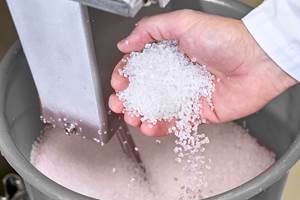After a Soft Start, Prices Are Firming
Polyolefin prices sledded downhill in December, while PVC skated on flat resin tabs.
Polyolefin prices sledded downhill in December, while PVC skated on flat resin tabs. But last month saw the first signs that PP, PS, and PVC prices were climbing back uphill.
PE prices down
Polyethylene prices were moving down by about 4¢/lb in January, following a similar drop in December. That final slump left the net rise in prices for 2005 at about 28¢/lb.
The last announced price hike, of 5¢/lb, was delayed from Dec. 1 to Jan. 1 and then delayed again. A new date for implementation has not been set. Meanwhile, prices are rising on the London Metal Exchange. The LME short-term futures contract for February 18 in g-p blown-film butene LLDPE sold at 57.7¢/lb, up from January’s 51.26¢ and December’s 49.9¢/lb.
Contributing factors: Resin tabs moved downward due to relatively weak demand in December and early January, coupled with inventory drawdown by processors. “We expect that within the next 30 to 45 days, the drawdown of inventories will have been completed,” said one major supplier in mid-January.
Industry sources concur that upward movement in prices is likely to recur once the inventory correction is worked out, possibly as early as the second quarter. Inventory restocking alone should prompt demand growth of 3% to 4% this year, and overall growth could reach 5% to 6%. Plant utilization rates, now reported to be somewhere in the 80% to 90% range, are expected to settle around 90% to 95% as the year progresses.
Despite lower spot prices for ethylene monomer in December, January contract prices were generally expected to remain at the December level of 56.5¢/lb. Several scheduled plant turnarounds taking place within the next three months are expected to keep monomer supply tight.
PP prices lower, too
Polypropylene prices dropped an average of 2¢ to 3¢/lb in December, although discounts of as much as 5¢ to 6¢ were widespread. But firming prices were evident early last month when most major suppliers issued a 4¢/lb price hike for Feb. 1.
LME’s February short-term futures contract for g-p injection-grade homopolymer rose to 53.2¢/lb, after a slight dip in January to 47.85¢ from December’s 48¢/lb.
Contributing factors: Lower resin tabs resulted from December’s propylene monomer contract prices dropping 5¢/lb, coupled with sluggish end-of-year demand and processors drawing down inventories. However, demand rebounded last month by about 20%, according to some suppliers, and is projected to continue on this path. Suppliers expect their plant utilization rates to run in the 90% to 95% range.
On the other side of the coin, slumping monomer prices will exert downward pressure on resin prices. At press time, proposed January contract prices were 4.5¢ lower than the month before.
PVC flat in January
January without a PVC price hike is a seasonal anomaly. But OxyChem’s attempt at a 4¢ hike on Jan. 1 met no support. (Formosa had led the market down 2¢ in December by announcing a price cut.) Instead, Shintech announced a 2¢ increase for Feb. 1, supported by Georgia Gulf and Formosa Plastics. OxyChem was considered likely to go along once Formosa made its move.
Contributing factors: At the end of January, OxyChem was due to shut down its 300-million-lb/yr PVC plant in Scotford, Alberta, in conjunction with Dow Chemical’s closure of a Canadian vinyl chloride monomer plant. With mild winter weather, gas futures were trending down and expected to be lower in February and March. January PVC demand was not bad but weaker than in December.
PS hikes announced
Polystyrene resin producers all supported a 6¢/lb increase for Feb. 1, except Chevron Phillips, which announced a 5¢ hike for that date. Whether producers go with 5¢ or 6¢ depends on where benzene prices are headed. Meanwhile, EPS prices were flat in January.
Contributing factors: Benzene rose from $2.18/gal in December to $2.46 in January, with spot benzene as high as $2.65/gal. (A 10¢ change in benzene cost equals roughly 1¢ for styrene monomer or PS.) EPS prices are sensitive to Asian imports, but Asian prices are firming.
| Market Prices Effective Mid-Jan A |
|
|
KEY: Colored areas indicate pricing activity. An arrow () indicates direction of price change. aTruckload, unless otherwise specified. bUnfilled, natural color, unless otherwise specified. cBased on typical or average density. dNot applicable. eNovolac and anhydride grades for coils, bushings, transformers. fNovolac and anhydride grades for resisitors, capacitors, diodes. gIn quantities of 20,000 lb. h19,800-lb load. jLME 30-day futures contract for lots of 54,564 lb.. |
Related Content
NPE2024 Materials: Spotlight on Sustainability with Performance
Across the show, sustainability ruled in new materials technology, from polyolefins and engineering resins to biobased materials.
Read MorePrices Bottom Out for Volume Resins?
Flat-to-down trajectory underway for fourth quarter for commodity resins.
Read MoreAutomotive Awards Highlight Emerging Technologies
Annual SPE Automotive event gives nods to several ‘firsts’ as well as sustainability.
Read MoreAutomotive Awards Highlight ‘Firsts,’ Emerging Technologies
Annual SPE event recognizes sustainability as a major theme.
Read MoreRead Next
Beyond Prototypes: 8 Ways the Plastics Industry Is Using 3D Printing
Plastics processors are finding applications for 3D printing around the plant and across the supply chain. Here are 8 examples to look for at NPE2024.
Read MoreMaking the Circular Economy a Reality
Driven by brand owner demands and new worldwide legislation, the entire supply chain is working toward the shift to circularity, with some evidence the circular economy has already begun.
Read MoreLead the Conversation, Change the Conversation
Coverage of single-use plastics can be both misleading and demoralizing. Here are 10 tips for changing the perception of the plastics industry at your company and in your community.
Read More











